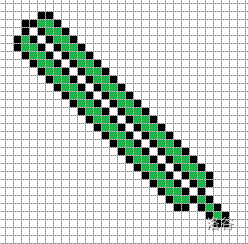- cuizixuan's blog
#2609 picture 目前记录 k~2n
- @ 2024-10-6 21:10:50
一个 的构造
构造

证明
设身体循环 次,尾巴循环 次,则
令
即可, 此时有
$$k=8\left\lfloor\frac{n-14}{4}\right\rfloor+3((n-14) ~\mathrm{mod}~ 4)+38 $$则
AC Code
标程都能下载了我在这放代码也行吧……
代码看着长其实很短,我写了一堆debug+封装+拆行,不长才怪。
#include <bits/stdc++.h>
using namespace std;
int n;
void small_main(){
printf("%d\n", 3*n+4);
printf(
"%d %d\n%d %d\n%d %d\n%d %d\n",
1, 1,
1, 2,
2, 1,
2, 2
);
for (int i=1; i<=n; i++){
printf(
"%d %d\n%d %d\n%d %d\n",
i+1, i+2,
i+2, i+1,
i+2, i+2
);
}
}
struct coord {
int x, y;
};
const int maxdebug=80;
char buf[90][90]; // debug only
struct Canvas {
vector<coord> ans;
int cur_row = 1;
void debug(){
memset(buf, ' ', sizeof buf);
for (int i=0; i<=maxdebug; i++){
buf[i][maxdebug+2] = '\n';
buf[i][maxdebug+3] = '\0';
}
for (coord &c: ans) {
buf[c.x][c.y] = '#';
}
for (int i=0; i<=maxdebug; i++){
cout << buf[i];
}
}
void output(){
printf("%d\n", ans.size());
for (coord &c: ans) {
printf("%d %d\n", c.x, c.y);
}
}
} canvas;
struct pattern {
int offset; // 左上角的 col-row
vector<string> pat;
void print(Canvas &out){
bool jumped = false;
int row = out.cur_row,
col = out.cur_row + offset;
for (int i=0; i<pat.size(); i++){
string &s = pat[i];
for (int j=0; j<s.size(); j++){
if (s[j]!=' '){
out.ans.push_back({i+row, j+col});
}
if (s[j]=='*'){
out.cur_row += i;
jumped = true;
}
}
}
if (!jumped) {
out.cur_row += pat.size();
}
}
};
// " ": 空白
// ".": 四度点
// "#": 二度点
// "*": 连接标识点
pattern head = {
0,
{
" ##",
" ##..#",
" # #..#",
"#.# #..#",
}
};
pattern body = {
-4,
{
"#..# #..#",
}
};
pattern back = {
-4,
{
"#..# #.#",
" #..# #",
" #..#*",
" ##"
}
};
pattern tail = {
0,
{
" #",
"#*",
}
};
int main(){
freopen("picture.in", "r", stdin);
freopen("picture.out", "w", stdout);
cin >> n;
if (n<=20){
small_main();
return 0;
}
int round = (n - 14) / 4,
left = (n - 14) % 4;
head.print(canvas);
while (round--) body.print(canvas);
back.print(canvas);
while (left--) tail.print(canvas);
// canvas.debug();
canvas.output();
return 0;
}
